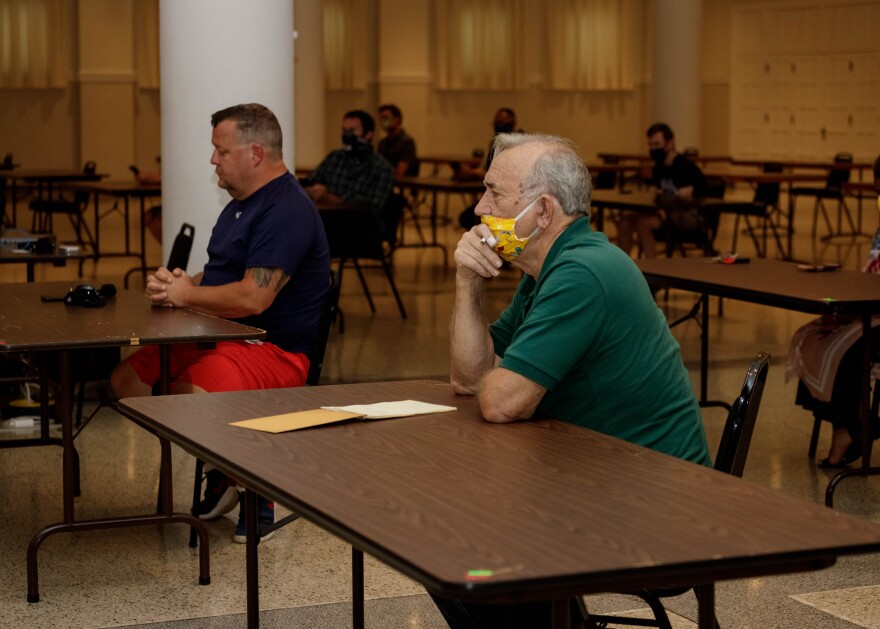Discussions about divesting from police departments continue across the nation in the wake of multiple shootings of Black Americans at the hands of white police officers this year.
Police and racial justice advocates added clarity to the conversation in Bloomington-Normal during a public Community Conversation hosted by the Bloomington Human Relations Commission on Thursday night.
Earlier this summer, Black Lives Matter (BLM) BloNo released a set of revamped demands that included a 50% overall decrease in local police budgets.

BLM BloNo leadership team member Olivia Butts said divestment means reallocating those millions of dollars toward services that address the root causes of crime, like mental illness, poverty, homelessness, and lack of access to education, food and health care. The reduction in crime would in turn reduce the need for police, Butts said.
At the forum, ISU Police Chief Aaron Woodruff said cuts at that scale would necessitate a reduced police force.
“No matter what department you look at, the majority of the costs are personnel,” he said, adding some of those costs are out of the department’s hands, like overtime for late-night calls or labor union mandates.
Butts said that’s exactly the idea.
Butts serves on the Minority and Police Partnership council. She said officers on the council have said their job has changed to include the role of therapist, counselor and mental health crisis responder.
“So yes, we would be reducing their staff to put other types of staff who are more qualified to handle those specific scenarios in the place of (police),” Butts said. “The police are trained to do a lot of things, but I don’t think that they’re necessarily trained to respond to some of those calls.”
Woodruff disagreed with that characterization.
While he agreed his officers are taking more mental health calls than ever, he said they’ve also had to adapt to effectively respond to those calls.
“The other piece to that, too, is who’s available 24 hours a day, seven days a week, and who’s going to get there first?” added Woodruff, noting that social workers sometimes ask for police protection when responding to calls.
Woodruff argued a large body of research shows police presence in the community reduces crime.
“So when you eliminate police, crime and violence can go up, and will go up,” he said.
Bloomington Interim Police Chief Greg Scott noted the majority of both Bloomington and ISU police officers receive Crisis Intervention Team (CIT) training that entails 40 hours of classroom and scenario-based education by mental health professionals. That helps officers understand what it’s like to suffer from mental illness, and how to safely restrain those individuals in violent situations.

Woodruff clarified new regulations require officers to complete two years on the job before they’re eligible for the training. “I don’t necessarily agree with that,” he said.
Scott also said BPD officers receive de-escalation training as part of an annual use-of-force training.
Mike Donnelly, who has worked in youth intervention and outreach for several years in Bloomington-Normal, thinks rather than reducing police budgets, the community should focus on taking full advantage of its existing resources.
He said when he worked as community impact manager at United Way of McLean County, “way before we started to see money shortages in social services, I began to talk with people in town about collaborating, working together. Unfortunately, some listened, and some didn’t, and the doors closed.”
School resource officers
Another of BLM BloNo’s demands is for Unit 5, District 87 and ISU to sever their contracts with local police departments and remove embedded officers from their schools.
Woodruff said he disagreed with that perspective.
“I’m all for a better and safer community,” he said. “It’s how do we go about doing it, and again, how do we not be the experiment when real lives are at stake, too? We have to think about all the unintended consequences.”
One of those unintended consequences may be preventing the development of a more diverse police force.
Asked what the community should be investing in, Linda Foster, president of the Bloomington-Normal branch of the NAACP, said a police force that better reflects the community could build better community relationships.
“We need to go out and make sure that young people are exposed to law enforcement in a positive way early on,” she said.
Woodruff said that’s going to be tough if there are no officers in schools. “If those officers, if they’re making positive connections with those young people in the schools, then we may be influencing them hopefully to one day look at this as a profession, and change the profession.”
Donnelly agreed youth should be at the center of any plan to reinvest in the community. He remembered a well-loved community center in the Sunnyside neighborhood.
“There were so many young people that we were able to get jobs for, there were so many different things that we were able to mediate going on out in the streets, putting families in housing, providing assistance when they needed it--it was a hub,” he said. Outside of perhaps barbershops and churches, young and incoming Black residents don’t have a hub now, Donnelly said.
Scott said he agreed with Donnelly on the importance of investing in youth, adding the BPD supports the Boys and Girls Club of Bloomington-Normal. “I think those are great ideas; I don’t think there’s a place in my budget to support that,” he said.
Butts said she’d also like to see greater investment toward solving homelessness in Bloomington-Normal, and creating a re-entry program for formerly incarcerated men, mirroring the Labyrinth program for women to help reduce recidivism.
WGLT depends on financial support from users to bring you stories and interviews like this one. As someone who values experienced, knowledgeable, and award-winning journalists covering meaningful stories in central Illinois, please consider making a contribution.





